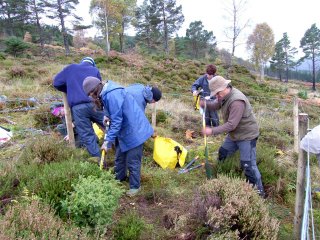"I first met the rest of my group at Inverness train station, not knowing what to expect.
As individuals turned up I shook their hand and we exchanged names, and we travelled via the minibus to Glen Morrison, where our work week was based.
On the way we stopped in a small section of forest for lunch and an introductory talk. Although it was only a small piece of natural Caledonian forest, you felt as though you where in a Jurassic park film, with the river raging and the lichens dripping from the trees.

On the following Sunday we started work. We would be taking down an old, now redundant fence in Forestry Commission land. I didn't really know how important this was but many rare black grouse are killed by fences each year as they fly low to the ground and sometimes may not see the fence, especially in foggy weather which is common!
Monday we started to make aspen enclosures quite hign up in the glen. Aspen does not disperse its seed very well; in fact it rarely produces seed at all, so planting them is important recreate the natural forest diversity. Unfortunately deer like to eat aspen leaves so deer fences must be made to protect the saplings. It took almost a day for four of us to complete one enclosure.
Other days included a red squirrel survey: As many of you probably know the grey squirrel has take over from the red squirrel in most places; however in predominantly coniferous forest, reds have a slight advantage and still cling on. Cutting down non-indigenous tree species is another important task. Sitka spruce in particular seeds vigorously and if left as they are they would out-compete birches, Scots pine and others, eventually killing them. In the evenings a couple from the group would cook a meal, which every day was great, followed down with a "wee dram" of single malt. Lovely. One of my favourite experiences was listening to a certain owl that lived somewhere in a small stand of lime trees near our accommodation, despite my best efforts of trying to spot it in the dark, I was reduced to just listening, for me it was a rare sound. It was certainly a great week for me and the others and would recommend it to anybody, the variety of people in my group was very broad!" - Jason Cheng
"The Tree Council, a national charity that promotes the planting and conservation of trees in town and countryside has two grant schemes available for 2007. These are the Trees for Schools Fund and the Communities Tree Fund. Under these funds grants of up to £700 are available both to schools and community groups proposing to undertake well-planned tree planting projects starting in 2007 during National Tree Week, 21st November to 2nd December. The closing date for both funding streams is the 31st May 2007". - We heard about this through SEL.










